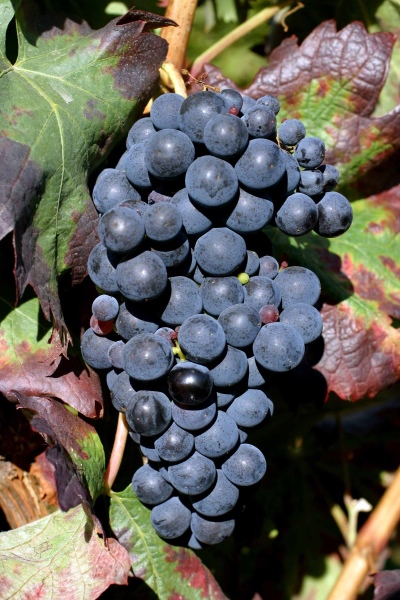
- Authors: Spain
- Appointment: technical
- Berry color: intense black with a matte finish
- Ripening period: late
- Frost resistance, ° C: -18
- Name synonyms: Aragonez, Aragones, Cencibel, Chinchigliano, Grenache de Logrono, Ojo de liebre, Tempranilla, Tempranillo de la Rioja, Tinta roriz, Tempranillo, Tempranillo tinto (Pais del Tempranillo) (Tinto del Tinto) , Tinto fino, Tinto Madrid, Tinto de la Rioja, Tinto de toro, Ull de llebre
- Flower type: bisexual
- Skin: thin
- Appeared when crossing: Albillo Major x Benedicto
- Berry shape: rounded or slightly flattened
The Tempranillo grape variety originated in Spain and translates as "early". Due to the early ripening period compared to other wine varieties, it gained fame throughout the Iberian Peninsula. Connoisseurs consider this grape to be a descendant of the Pinot noir variety.
Breeding history
According to legend, pilgrim monks from Burgundy brought cuttings of Pinot noir grapes to the northern province of Spain - Rioja. But historical evidence is lacking, and biological examination denies the related roots of these varieties of grapes.
Geography of distribution
The Tempranillo grape, due to its unpretentiousness and excellent quality of the fruit, began to be grown in the center and in the north of Spain. In the 18th century, Tempranillo spread to Portugal. By the end of the 20th century, North America, Europe, Australia, Argentina showed interest in it.
On the territory of the Russian Federation, the variety is cultivated only in warm areas:
- Krasnodar region;
- Dagestan.
In Russia, Tempranillo grapes are cultivated by about 1% of the country's producers. In other regions, this culture can get sick or die, and the berries will be small and sour in taste.
Description
The Tempranillo grape has a fast growing shrub with few leaves. The leaves are large, wrinkled. The plant can have 20 shoots at once, about 7 meters long, which have time to fully ripen.
Ripening period
The growing season is 4-4.5 months, but on condition that the culture grows in a climate similar to the Mediterranean. Then ripening can occur 1-2 weeks earlier.
Bunches
The brushes of this variety are similar to small cones and reach a weight of 600-700 grams. Juveniles are often prone to cluster peas.
Berries
The size of Tempranillo grapes is small, up to 1.5 cm in diameter. The skin is dark with a tint of color. One berry weighs about 8 grams. This grape variety receives the highest tasting marks.
Taste
Fruits with sufficient sugar content and acidity. With frequent rains and high humidity, the taste of the berries deteriorates, and the flesh becomes watery. Wine from such a harvest will be of poor quality.
The Tempranillo grape is a popular variety in Spain and Portugal. Famous port wines with different fruit aftertaste are a feature of this grape.
Yield
Due to the small size of the bush, planting is recommended to be done more often. The yield from this only increases. During heavy rains, the ovary and flowers do not crumble, which does not harm the crop. The yield is influenced by the fertility of the land and high mountain climatic conditions.
If you cultivate this pearl of Spain correctly, you can get bountiful harvests - about 5 kg of grapes per bush.


Growing features
This variety is quite capricious and requires special cultivation conditions:
- the use of trellises for tying vines;
- prevention of diseases and pests about 3 times a year;
- sanitary and formative pruning of the bush to increase the yield;
- formation of underground irrigation, mulching and soil drainage;
- top dressing with organic and mineral fertilizers.
Landing
This crop is planted in May, when the threat of frost has passed and daylight hours increase. This is necessary for the development of shoots and the formation of ovaries.

Pollination
Flowers have the properties of both sexes (bisexual), so no artificial pollination is required.
Pruning
The grape bushes are pruned every year, in spring and autumn. Due to the fact that the vine has a large distance between the nodes, it is cut into 6-7 buds. After pruning, the bush takes on the shape of a "goblet". In the spring, they get rid of 80% of the growth of last year. This pruning operation should only be carried out on healthy plants.
Garden tools should be well sharpened and disinfected. Pruned vines need to be treated with garden varnish.

Watering
The correct watering regime doubles the yield of this grape variety. There are two methods of watering the vine.
- In a trench or furrow. The disadvantage of this method is the excessive moisture content of the top layer. This can contribute to the onset of fungal diseases.
- In the drainage in the form of a hole or hole. The advantage of this method is that moisture and nutrients immediately go to the root system of the bush.
There are vegetative and moisture-charging irrigation. Vegetation irrigation is carried out in stages:
- to swelling of the kidneys;
- after flowering;
- after the formation of the berries.
Moisture loaders are produced in spring and autumn. If the seedling is planted in the fall, then watered with cold water. In the spring, on the contrary, with warm water.


Frost resistance and the need for shelter
The Tempranillo grape is afraid of frost, so it needs shelter. For this, straw, non-woven material is used.

Diseases and pests
Tempranillo grapes lack immunity to a number of diseases:
- gray rot;
- mildew;
- oidium.
The treatment is carried out with contact action fungicides and insecticides. The most dangerous pest is phylloxera, which is found in the roots of grapes and leads to death of the bush. Only chemical treatment will help.

If a grape is exposed to any disease or insect, this always affects its appearance.
Storage
Harvesting Tempranillo grapes is done in dry weather using a sharp knife or pruner. This grape variety is practically not stored, but is completely sent for processing, for making wine.











































































